Smells like Paradise: Scent Vessels in Eighteenth-Century Paris
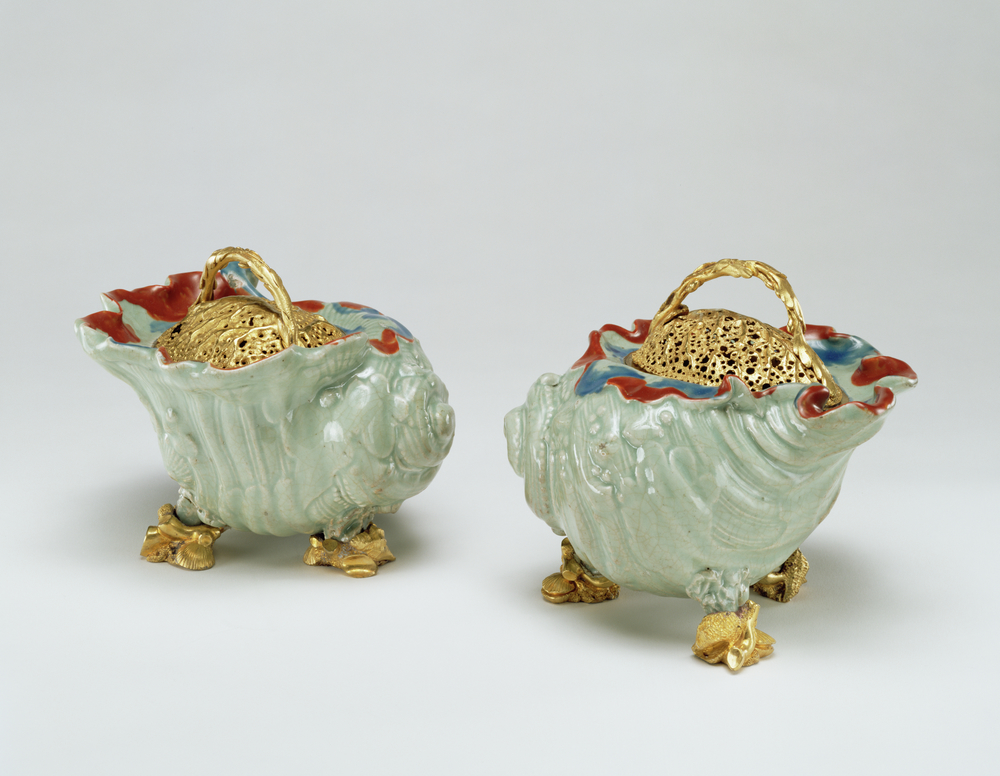
Pair of Potpourri Bowls. Japanese porcelain, c. 1660-80; French gilt-bronze mounts, c. 1750. J. Paul Getty Museum.
Editor’s note: Today we present the third in our series of posts previewing the upcoming Home Subjects panel “Art and/in the Private House” at the annual meeting of the American Society for Eighteenth-Century Studies in Minneapolis, Minnesota, March 30-April 2 2017. Next up is Hyejin Lee, who is a Ph.D. candidate in art history at the University of North Carolina at Chapel Hill. –ANR
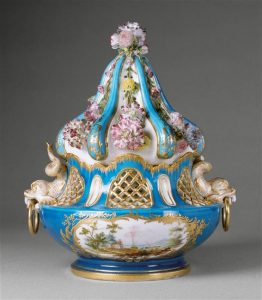
One of a pair of potpourri vases “à dauphins” (in the form of a dolphin). Soft-paste porcelain, 1755. Manufacture de Vincennes and Sèvres, Louvre OA11300.
Potpourri, a fragrant mixture of dried flowers and plant material, enjoyed a ubiquitous presence in eighteenth century interiors. After its sudden advent in the late 1600s, potpourri (and the eponymous vessels that held it) adorned the mantels and tabletops of elegant residences. Other forms of household fragrance, such as liquid perfume and pastilles (dry pellets made of aromatic substances) burned in containers called cassolettes and brûle-parfums, were also popular. In addition, floral vases, whether for cut flowers or for potted bulbs, proliferated in elite interiors of this period.
These fragrance vessels were constructed and decorated with all the materials available for luxury furnishings of the time, such as gold, silver, lacquerware, colorful hardstones, and gilt bronze. Porcelain of East Asian or European origin was an especially favored medium of choice for potpourri vases due to its impermeable and durable qualities. Decorative elements of scents vases employed a full range of Rococo and Neoclassical ornamental lexica, including floral and vegetal motifs; exotic natural elements, such as rare birds and seashells; chinoiserie; singerie; grotesque; and mythical creatures.
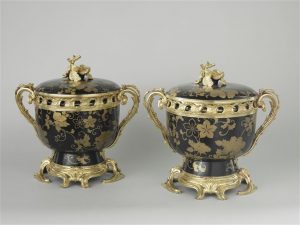
Pair of lidded Japanese lacquer bowls mounted as potpourri vases. Bowls and lids: Japanese lacquer, c. 1680-1730; French gilt-bronze mounts, 1745-49. Mobilier National, OA5148.
To modern readers, who are accustomed to scented candles and essential oil diffusers in their domestic environment, the profusion of potpourri in homes of the privileged ranks of the eighteenth century may not come as a surprise. But the sudden emergence and wild popularity of these objects, to say nothing of the sheer expense in material and labor mobilized to create them, suggest that perfumed air had meanings very specific to European life during this period. Why were wealthy consumers so fascinated and enthusiastic about perfuming the air in their homes? What did perfumed air purport to do? And how did household perfumes and their vessels perform these roles?
Before delving into these issues, we need first to consider how it smelled in Paris without perfume’s intervention. Nicknamed the “city of mud,” Paris was notorious for its stench in the eighteenth century. The city’s air was polluted by various factors, such as crowded buildings, lack of sewage and garbage disposal systems, and inclusion within municipal boundaries of slaughterhouses, cesspools, tanneries, hospitals, cemeteries, and churches where putrescence abounded. Impregnated by fetid matters, air transformed into a thick fog of miasma, sickening its inhabitants every day.
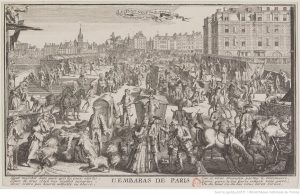
Nicolas Guérard’s engraving, Le Pont-Neuf veu du coté de la rue d’Auphine [sic]: l’embaras de Paris. 1715. Bibliothèque nationale de France, available on Gallica.
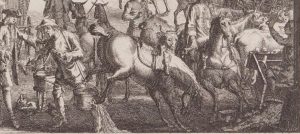
Nicolas Guérard’s engraving, Le Pont-Neuf veu du coté de la rue d’Auphine [sic]: l’embaras de Paris, detail of the lower right corner. 1715. Bibliothèque nationale de France, available on Gallica.
Given this theoretical context, scented materials and flowers offered protection against miasma and infection in private homes. Perfume masked the stench seeping in from outside and filled the interior space with sensory markers of salubrious air. Just as patients in hospitals inhaled the smoke of burning juniper berries and pastilles to help expedite their recovery, wealthy Parisians who enjoyed relatively good health relied on household perfume as a form of prophylaxis.
Scent vessels participated in preventive medical practice not only with the healthful perfume they emitted, but also with their visual and material elements. Fittingly, the decoration on scent vessels makes references to places such as outdoor gardens, countryside, and faraway or fantastical realms, where air smells better and is thus more salubrious than that of the city.
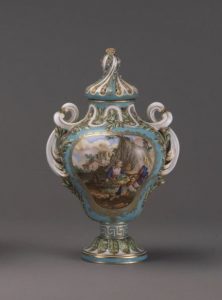
One of a set of three lidded potpourri vases. soft-paste porcelain, c. 1762. Manufacture de Sèvres. Huntington Library, Art Collections, and Botanical Gardens.
For example, in a potpourri vase at the Huntington Library, vegetal motifs, such as the flowers, foliage, reeds, and myrtle leaves (which was one of the frequent ingredients of potpourri during this period), evoke a flower garden exuding fresh, natural fragrance that was hailed as an antidote for the fetor characterizing urban life. The figural vignette set in a pear-shaped frame shows a scene at the Italian gardeners’ market, visualizing a rustic landscape with a distinct olfactory profile. Selling their harvest in an open-air market, peasants breathe in the fresh air of the countryside, far from the stagnant, noxious city air. Indeed, the figure of the robust, healthy peasant was a foil for the enervated and sickly city dweller in French literature from the mid-eighteenth century.
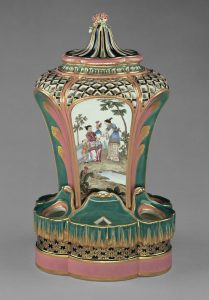
Pair of potpourri vases and details of painted scenes. Soft-past porcelain, painting attributed to Charles-Nicolas Dodin, 1760. Manufacture de Sèvres. J. Paul Getty Museum.
A pair of Sèvres potpourri vases at the J. Paul Getty Museum, incorporates enamel paintings inspired by chinoiserie scenes found in export porcelain. In one vase, an elegant woman presents a floral arrangement in a vase to another.
In another, a different woman greets a child while seated next to a similar tall vase with a single flower. Both vignettes present the scene in a garden setting, indicated by the threes, shrubs, and flowers that adorn them. The vases’ visual and material evocation of a fragrant garden in a distant land diverts the viewer-user’s attention from repulsive air of here (Paris) to sweet-smelling air of elsewhere (the imagined Orient), thereby reinforcing perfume’s role in correcting and improving the air in a given space.
Perfume’s aroma, and its vessels’ visual-material cues to the scent of elsewhere provided multi-sensory distractions from the stench of reality, the intolerable effluvia of death and decay that shrouded Paris. These decorative objects, through tangible (with ornamental motifs and material) and intangible (with fragrance) means, prompted imaginary transports to fantastical places, enveloped in healthful, fragrant air and free of the threat of disease.